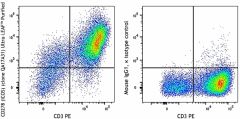- Clone
- QA17A31 (See other available formats)
- Regulatory Status
- RUO
- Other Names
- Inducible Costimulator, H4
- Isotype
- Mouse IgG1, κ

-

PHA-stimulated (three days) human peripheral blood lymphocytes were stained with CD3 PE and Ultra-LEAF™ Purified CD278 (ICOS) (clone QA17A31, left) or Ultra-LEAF™ Purified mouse IgG1, κ isotype control (right), followed by anti-mouse IgG Alexa Fluor® 647.
| Cat # | Size | Price | Quantity Check Availability | ||
|---|---|---|---|---|---|
| 396503 | 100 µg | $314.00 | |||
| 396504 | 1 mg | $693.00 | |||
Select size of product is eligible for a 40% discount! Promotion valid until December 31, 2024. Exclusions apply. To view full promotion terms and conditions or to contact your local BioLegend representative to receive a quote, visit our webpage.
ICOS, also known as inducible costimulatory molecule and H4, is a 47-57 kD protein. This protein is homologous to the CD28/CTLA-4 proteins. ICOS is expressed on activated T cells and a subset of thymocytes. It is able to costimulate T cells proliferation. In addition, ICOS is involved in humoral immune responses (B cell germinal center formation). The ICOS ligand is B7h/B7RP-1 or B7-H2. ICOS stimulation has been shown to potentiate TCR-mediated IL-4 and IL-10 production and has been proposed to play a role in Th2 cell development.
Product Details
- Verified Reactivity
- Human, Mouse, Rat
- Antibody Type
- Recombinant
- Host Species
- Mouse
- Immunogen
- Mouse T cell clone D10.G4.1
- Formulation
- 0.2 µm filtered in phosphate-buffered solution, pH 7.2, containing no preservative.
- Preparation
- The Ultra-LEAF™ (Low Endotoxin, Azide-Free) antibody was purified by affinity chromatography.
- Concentration
- The antibody is bottled at the concentration indicated on the vial, typically between 2 mg/mL and 3 mg/mL. Older lots may have also been bottled at 1 mg/mL. To obtain lot-specific concentration and expiration, please enter the lot number in our Certificate of Analysis online tool.
- Storage & Handling
- The antibody solution should be stored undiluted between 2°C and 8°C. This Ultra-LEAF™ solution contains no preservative; handle under aseptic conditions.
- Application
-
FC - Quality tested
- Recommended Usage
-
Each lot of this antibody is quality control tested by immunofluorescent staining with flow cytometric analysis. For flow cytometric staining, the suggested use of this reagent is ≤ 0.125 µg per million cells in 100 µl volume. It is recommended that the reagent be titrated for optimal performance for each application.
- RRID
-
AB_2810604 (BioLegend Cat. No. 396503)
AB_2810604 (BioLegend Cat. No. 396504)
Antigen Details
- Structure
- CD28/CTLA-4, 47-57 kD
- Distribution
-
Activated T cells, subset of thymocytes
- Function
- Costimulates T cell activation, proliferation, humoral immune response
- Ligand/Receptor
- B7h/B7RP-1/GL-50/CD275
- Antigen References
-
- Redoglia V, et al. 1996. Eur. J. Immunol. 26:2781.
- Hutloff A, et al. 1999. Nature 397:263.
- Buonfiglio D, et al. 2000. Eur. J. Immunol. 30:3463.
- Coyle AJ, et al. 2000. Immunity 13:95.
- Gene ID
- 10048841 View all products for this Gene ID 29851 View all products for this Gene ID 64545 View all products for this Gene ID
- UniProt
- View information about CD278 on UniProt.org
Other Formats
View All CD278 Reagents Request Custom Conjugation| Description | Clone | Applications |
|---|---|---|
| Ultra-LEAF™ Purified anti-human/mouse/rat CD278 (ICOS) Recombinant Antibody | QA17A31 | FC |
Compare Data Across All Formats
This data display is provided for general comparisons between formats.
Your actual data may vary due to variations in samples, target cells, instruments and their settings, staining conditions, and other factors.
If you need assistance with selecting the best format contact our expert technical support team.
-
Ultra-LEAF™ Purified anti-human/mouse/rat CD278 (ICOS) Recombinant Antibody

PHA-stimulated (three days) human peripheral blood lymphocyt...
